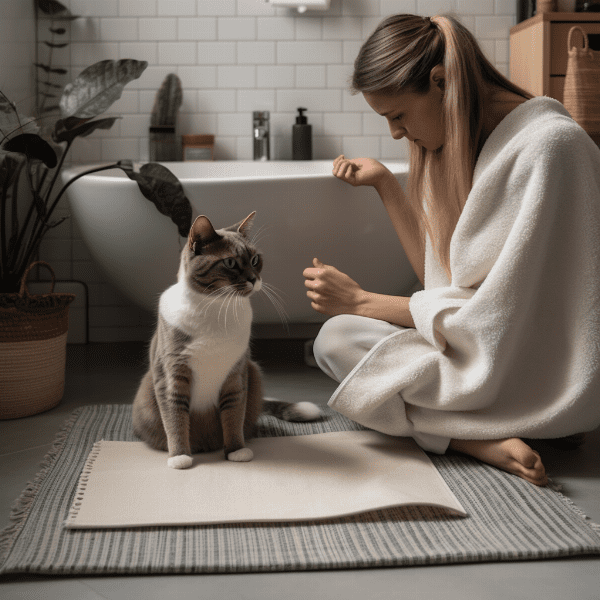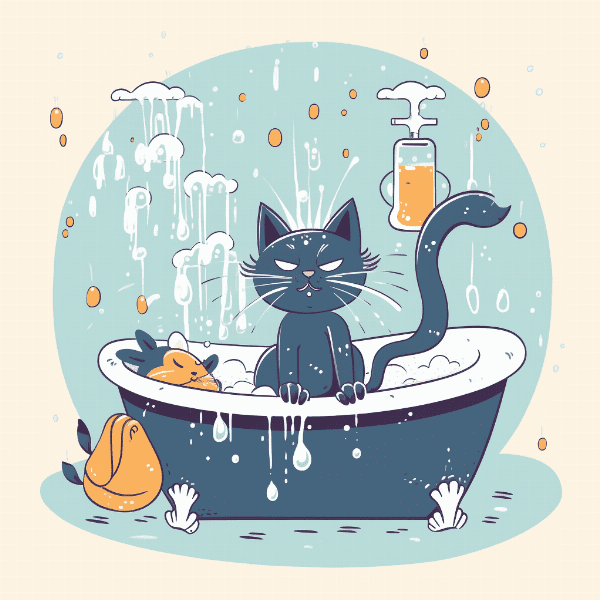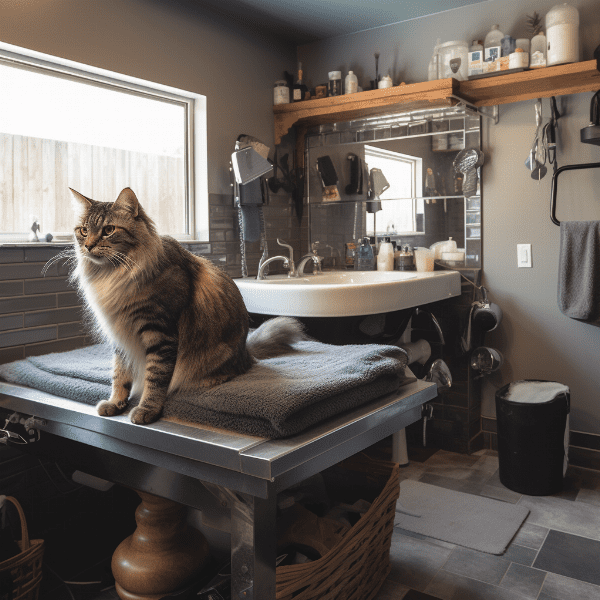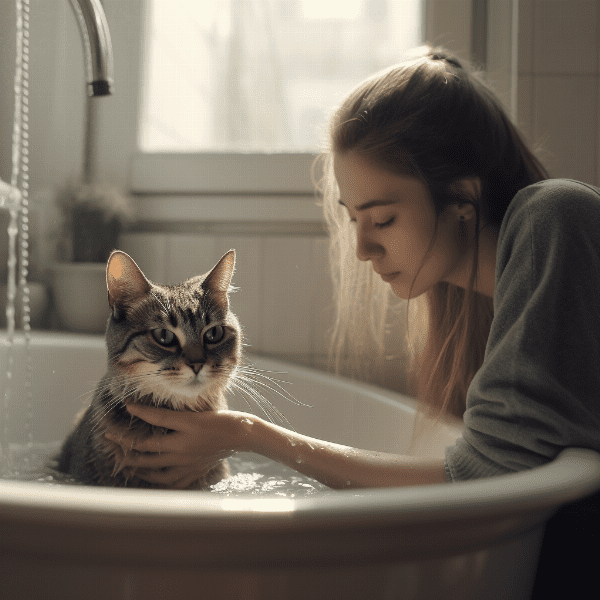Table of Contents
- Understanding the Cat’s Instinctual Resistance to Water
- Signs Your Cat Hates Bath Time
- Preparing for Bath Time: Tips and Tricks
- Navigating Bath Time: Step-by-Step Guide
- Dealing with the Aftermath: Calming Your Cat Post-Bath
- Alternative Methods for Keeping Your Cat Clean
- Seeking Professional Help: When to Consider a Groomer or Vet
- Prevention is Key: How to Avoid Bath Time Battles in the Future.
Understanding the Cat’s Instinctual Resistance to Water
Cats are renowned for their fastidious grooming habits, and in many cases, a bath may seem like a completely unnecessary endeavor. However, there are situations where a bath is essential, such as when your cat has come into contact with something harmful or has developed a skin condition. Despite these circumstances, many cats instinctively resist being submerged in water, leading to a potential battle between cat and owner.
The Root of the Issue: Instinctual Behaviors
One reason why cats may react negatively to water is due to their instinctual behavior. As natural hunters, cats have developed an innate aversion to water, as they recognize that being wet can hinder their hunting ability. This instinctual behavior is also why cats may be hesitant to drink from water sources that are unfamiliar or stagnant.
Fear and Anxiety
In addition to instinctual behaviors, fear and anxiety may also play a role in a cat’s resistance to water. Cats are creatures of habit and routine, and anything that deviates from their usual day-to-day experiences may trigger fear or anxiety. The unfamiliar sensation of water combined with the close quarters of a tub or sink may cause your cat to feel trapped and overwhelmed, leading to panic and a fight-or-flight response.
Sensitivity to Temperature and Sound
Cats are known for their sensitivity to temperature and sound, which can also contribute to their dislike of water. Bathwater that is too hot or too cold can cause discomfort and even pain for your cat. Additionally, the sound of running water may be alarming or stressful for some cats, leading to further resistance.
Conclusion
Understanding why cats may hate bath time can help you approach the situation with greater empathy and compassion. By acknowledging your cat’s instinctual behaviors, fears, and sensitivities, you can work to make the experience as stress-free as possible. With patience and practice, you can help your feline friend overcome their resistance to water and create a positive bathing experience for both of you.

Signs Your Cat Hates Bath Time
As a cat owner, it’s essential to recognize the signs that your feline friend is uncomfortable or stressed during bath time. By being attuned to their behavior, you can make the experience as positive and stress-free as possible. Here are some common signs that your Cat hates bath time:
Hiding or Running Away
One of the most obvious signs that your cat dislikes bath time is when they try to hide or run away. This behavior is a clear indication that they want to avoid the situation altogether. If your cat disappears when you start preparing for bath time or makes a beeline for the door as soon as they see the tub, they are likely feeling scared or anxious.
Aggression or Hissing
If your usually docile cat suddenly becomes aggressive or starts hissing during bath time, they may be feeling threatened or trapped. This behavior is a natural response to stress or fear, and it’s important to take a step back and give your cat space to calm down.
Vocalizations
Some cats may express their discomfort through vocalizations, such as meowing, growling, or yowling. These vocalizations are a clear sign that your cat is feeling distressed and may be asking for help. If your cat is meowing or crying during bath time, it’s essential to remain calm and reassuring to help them feel safe and secure.
Struggling or Scratching
If your cat is struggling or scratching during bath time, they may be trying to escape or defend themselves. While this behavior can be frustrating for the owner, it’s essential to remember that your cat is acting out of fear and stress. Avoid scolding or punishing your cat, as this will only make the situation worse.
Conclusion
Recognizing the signs that your cat hates bath time is the first step towards creating a positive and stress-free bathing experience. By understanding your cat’s behavior and needs, you can work to make bath time a less daunting task for both you and your feline friend. Remember to approach the situation with patience and compassion, and always prioritize your cat’s well-being.

Preparing for Bath Time: Tips and Tricks
Preparing for bath time can make all the difference in creating a stress-free experience for both you and your cat. By taking the time to plan and prepare, you can help to minimize your cat’s anxiety and ensure that everything runs smoothly. Here are some tips and tricks for preparing for bath time:
Gather Your Supplies
Before you start bath time, it’s important to have all the necessary supplies on hand. This includes a shampoo formulated for cats, a cup or pitcher for rinsing, a towel, and a non-slip mat for the tub or sink. It’s also helpful to have treats or toys on hand to reward your cat for their cooperation.
Choose the Right Time
Timing is everything when it comes to bath time. Choose a time when your cat is relaxed and calm, such as after a meal or a play session. Avoid scheduling bath time during a time when your cat is already stressed or anxious, such as during a thunderstorm or when there are loud noises outside.
Create a Calm Environment
Setting the right environment can make a big difference in your cat’s comfort level during bath time. Create a calm and quiet space free from distractions and loud noises. You can also use a calming spray or pheromone diffuser to help reduce your cat’s anxiety.
Gradual Introduction to Water
If your cat is particularly fearful of water, you can gradually introduce them to the sensation before bath time. Offer your cat a shallow container of water to play in, or use a damp cloth to gently rub their fur. This can help to desensitize your cat to the sensation of water and make bath time less daunting.
Conclusion
Preparing for bath time may take some extra effort, but it can make all the difference in creating a positive and stress-free experience for your cat. By gathering your supplies, choosing the right time, creating a calm environment, and gradually introducing your cat to water, you can help to minimize their anxiety and ensure a successful bath time. Remember to be patient and gentle, and always prioritize your cat’s comfort and well-being.

Navigating Bath Time: Step-by-Step Guide
Bath time can be a daunting experience for both you and your cat, but with the right approach, it can be a stress-free and positive experience. Here is a step-by-step guide to help you navigate bath time successfully:
Step 1: Prepare the Bathing Area
Before you begin, ensure that the bathing area is ready. Fill the tub or sink with warm water and add the shampoo. Place the non-slip mat in the bottom of the tub or sink and have the rinsing cup or pitcher ready.
Step 2: Gently Place Your Cat in the Water
Gently place your cat in the water and use a cup or pitcher to wet their fur. Be careful not to get water in your cat’s ears, eyes, or nose. Use a gentle touch and avoid sudden movements to help your cat feel safe and secure.
Step 3: Lather and Rinse
Apply the shampoo and gently massage it into your cat’s fur, taking care to avoid their face and ears. Use the rinsing cup or pitcher to thoroughly rinse your cat’s fur, ensuring that all of the shampoo is removed.
Step 4: Towel Dry
Once the shampoo is rinsed out, lift your cat out of the water and wrap them in a towel. Gently pat them dry, taking care not to rub or irritate their skin.
Conclusion
Bath time can be a challenging experience for cats, but with the right approach, it can be a positive and stress-free experience. By following this step-by-step guide and using patience and gentle touch, you can help to create a safe and comfortable environment for your cat during bath time. Remember to always prioritize your cat’s comfort and well-being and approach the situation with empathy and compassion.

Dealing with the Aftermath: Calming Your Cat Post-Bath
After bath time, your cat may still be feeling stressed or anxious. It’s important to take steps to help them calm down and feel safe and secure. Here are some tips for dealing with the aftermath of bath time:
Step 1: Dry Your Cat Thoroughly
After bath time, it’s important to dry your cat thoroughly to prevent them from feeling cold or uncomfortable. Use a towel to pat them dry, or use a hair dryer on a low setting if your cat is comfortable with the noise.
Step 2: Provide a Safe and Comfortable Space
Create a safe and comfortable space for your cat to relax after bath time. Provide a warm and cozy bed or blanket and place it in a quiet and secluded area away from noise and activity.
Step 3: Use Calming Techniques
Use calming techniques to help your cat relax and reduce their anxiety. This can include playing calming music, using pheromone sprays or diffusers, or giving your cat a gentle massage.
Step 4: Offer Treats and Rewards
Offer your cat treats and rewards for their cooperation during bath time. This positive reinforcement can help to reinforce positive associations with bath time and make future bath times less daunting.
Step 5: Monitor Your Cat’s Behavior
Monitor your cat’s behavior after bath time to ensure that they are recovering well. If your cat seems excessively anxious or stressed, or if they exhibit signs of illness or discomfort, seek veterinary attention.
Conclusion
Dealing with the aftermath of bath time can be just as important as the bath itself. By taking steps to help your cat calm down and feel safe and secure, you can help to create a positive and stress-free experience for both you and your feline friend. Remember to always prioritize your cat’s comfort and well-being and approach the situation with empathy and compassion.

Alternative Methods for Keeping Your Cat Clean
While bath time may be necessary in certain situations, there are alternative methods for keeping your cat clean that may be more suitable for some cats. Here are some alternative methods to consider:
Waterless Shampoo
Waterless shampoo is a great alternative to traditional bath time, as it allows you to clean your cat’s fur without using water. Simply apply the waterless shampoo to your cat’s fur, massage it in, and then towel dry. This method is great for cats who are particularly fearful of water.
Brushing
Regular brushing can help to remove dirt, debris, and loose fur from your cat’s coat, keeping them clean and tidy. Brushing also helps to distribute natural oils throughout your cat’s fur, keeping it soft and shiny. Depending on your cat’s coat type, you may need to brush them daily or weekly.
Wipes and Sprays
There are a variety of wipes and sprays available that are designed to clean your cat’s fur without using water. These products are great for spot cleaning, such as after your cat has rolled in something dirty or smelly. Be sure to choose a product that is formulated specifically for cats and avoid using products that contain harsh chemicals.
Professional Grooming
If you’re struggling to keep your cat clean on your own, consider taking them to a professional groomer. A groomer can provide a variety of services, such as bathing, trimming, and nail clipping, and can help to keep your cat looking and feeling their best.
Conclusion
While bath time may be necessary in certain situations, there are alternative methods for keeping your cat clean that may be more suitable for some cats. Waterless shampoo, brushing, wipes and sprays, and professional grooming are all great options to consider. Remember to choose a method that works best for your cat’s individual needs and always prioritize their comfort and well-being.

Seeking Professional Help: When to Consider a Groomer or Vet
While there are many things you can do at home to keep your cat clean, there may be times when you need to seek professional help. Here are some situations where you may want to consider taking your cat to a groomer or veterinarian:
Excessive Matting or Shedding
If your cat’s fur has become excessively matted or they are shedding excessively, it may be time to take them to a groomer. A groomer can help to remove mats and tangles, as well as provide a haircut if necessary. Additionally, if your cat is shedding excessively, a groomer can provide a deshedding treatment to help minimize shedding.
Skin Conditions or Allergies
If your cat has developed a skin condition or allergies, it’s important to seek veterinary attention. Your vet can provide a diagnosis and treatment plan to help alleviate your cat’s symptoms. In some cases, regular bathing may be necessary to help manage the condition.
Nail Trimming
Trimming your cat’s nails can be a daunting task, especially if your cat is resistant or aggressive. A groomer can provide professional nail trimming services, ensuring that your cat’s nails are trimmed safely and effectively.
Behavioral Issues During Bath Time
If your cat exhibits severe behavioral issues during bath time, such as aggression or excessive fear, it may be time to seek professional help. A veterinarian or animal behaviorist can help to identify the root cause of the behavior and provide a treatment plan to help manage the issue.
Conclusion
While there are many things you can do at home to keep your cat clean, there may be times when professional help is necessary. Excessive matting or shedding, skin conditions or allergies, nail trimming, and severe behavioral issues during bath time are all situations where seeking professional help may be beneficial. Remember to prioritize your cat’s comfort and well-being, and seek help when necessary to ensure that your feline friend stays happy and healthy.

Prevention is Key: How to Avoid Bath Time Battles in the Future.
Prevention is always the best strategy when it comes to keeping your cat clean and healthy. By taking steps to prevent the need for frequent baths, you can avoid bath time battles in the future. Here are some tips for preventing the need for frequent baths:
Regular Grooming
Regular grooming can help to prevent the buildup of dirt and debris in your cat’s coat, reducing the need for frequent baths. Brush your cat’s fur regularly to remove loose fur and prevent matting, and use wipes or sprays to spot clean when necessary.
Indoor-Only Lifestyle
If your cat is strictly an indoor cat, they may not need to be bathed as frequently as outdoor cats. Indoor cats are generally cleaner and have less exposure to dirt and debris, reducing the need for frequent baths.
Healthy Diet
A healthy diet can help to promote a healthy coat and reduce the need for frequent baths. Feed your cat a high-quality diet that is rich in essential nutrients and free from fillers and artificial preservatives.
Environmental Enrichment
Provide your cat with plenty of toys, scratching posts, and climbing structures to keep them mentally stimulated and physically active. This can help to reduce stress and anxiety, reducing the likelihood of skin issues or excessive grooming.
Conclusion
Prevention is the best way to avoid bath time battles in the future. By taking steps to keep your cat clean and healthy through regular grooming, an indoor-only lifestyle, a healthy diet, and environmental enrichment, you can minimize the need for frequent baths. Remember to always prioritize your cat’s comfort and well-being, and seek professional help when necessary to ensure that your feline friend stays happy and healthy.




